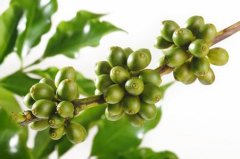Carefully filter "sick coffee beans to select defective beans"

Defective beans, as the name implies, are defective beans, and poor beans are like bad apples. The causes of the attacks are various and there are many kinds. Let's give a detailed introduction to the things that affect the quality of coffee.
A variety of factors can cause bad behavior. The breeding of defective beans can occur as large as the growth of coffee trees and as small as the process of harvest and treatment of raw beans. But do not despise these lacking beans, if the beans adopted by one or even several coffee bars are full of harmful beans, it will not only affect the coffee civilization of my own brand, but also seriously affect the market merger rate of the entire coffee chain and the reputation of coffee joining the market.
Raw coffee beans will absorb the ingredients contained in the soil of the planting land, and if they contain too much iodine, as in the soil of Rio de Janeiro, Brazil, the final coffee accumulated after adsorption will also have iodine flavor, although it may not be very significant. On the premise of the weather of the coffee growing place, the amount of rainfall will affect the growth of raw coffee beans, and the coffee beans with poor growth will also occur due to lack of nutrients. Worms drill into the coffee fruit to lay eggs and simply form pest beans. Other growth conditions also make up two extraordinary disadvantages: beans and beans. Elephant beans are bigger than ordinary raw beans. Round beans are literally a coffee fruit with only one round seed. When the number of these two kinds is small, it will not have much effect on the taste of coffee, but it is best to pick them out by hand and compare them with each other until the end of the day.
Next, the author introduces several kinds of bad beans for you in detail.
Moldy beans: due to dull and impure, or damp in the process of transportation and retention, cyan and white molds grow, which occasionally make beans stick together. If these moldy beans are not removed, mildew will occur.
Dead beans: beans with non-abnormal results. Color is not easy to be tampered with by baking, so it is easy to identify it. Graceful and thin, as harmful and beneficial as silver skin, will become the origin of the smell.
Young beans: beans that are picked before they are young have a fishy and disgusting taste. Leaving raw coffee beans for several years is a strategy to deal with these immature beans.
Shell beans: angry due to poor boredom or incomparable mating; the beans are separated from the central line and turned out like shells on the inside. Shell beans will form uneven baking and burn easily when developing deep baking.
Moth-eaten beans: moths invade and lay eggs when the coffee fruit turns red, the larvae eat the coffee fruit and grow, leaving traces of moth on the outside of the beans. Moth-eaten beans will make the coffee liquid cloudy and sometimes have a strange smell.
Black beans: early children withered in the air, permanent engagement with the sky and fermented black beans. It can be easily removed by hand-selected flashback. Coffee mixed with black beans will taste erosive and muddy.
Shell beans: the endocarp cage covers the inside of the pulp of coffee beans, and most of them remain on the washed coffee beans. It has poor heat permeability when roasting, and sometimes catches fire, which is an advertisement that causes the astringent taste of coffee. There are other beans, red peas (beans that rain in the process of artificial drying, which taste flat and monotonous), stunted beans (small grains of beans that stop growing because of insufficient nutrients, full-bodied taste), and so on. Occasionally mixed with corn or pepper, and so on.
Stone: beans harvested are easily mixed with stone or sawdust due to artificial drying.
Hand selection order:
1. Take too many raw beans and put them in a tray.
two。 Select raw beans until there is no error or fallacy.
3. Not just stare at one side of the bean, but pick it up to see its color and shape. Don't miss any one, move your eyes from left to left.
4. Keep walking at a strange pace
5. It is known that the average value of picking out the error error bean.
Important Notice :
前街咖啡 FrontStreet Coffee has moved to new addredd:
FrontStreet Coffee Address: 315,Donghua East Road,GuangZhou
Tel:020 38364473
- Prev

South American beans-occasionally there are "unobtrusive surprises"
There is no doubt about South American coffee, especially Brazilian coffee, and without much introduction everyone will remember a lot about its image. Brazil is the world's largest coffee producer and one of the birthplaces of coffee culture, producing fine washed coffee of excellent quality as well as coffee for general market use. A lot of people think Brazilian coffee is bland, not like Chinese coffee.
- Next

Teach you how to determine the freshness of coffee beans
Defective beans, as the name implies, are defective beans, bad beans, just like bad apples. There are a variety of reasons and many kinds of coffee. Here is a detailed description of the things that affect the quality of coffee. A variety of factors can cause defective beans. Defective beans can be produced as large as the growing environment of coffee trees and as small as the process of harvesting and processing raw beans. But don't.
Related
- Guji coffee producing area of Guji, Ethiopia: Humbela, Shakiso, Wulaga
- What is the most expensive variety of Qiloso in BOP multi-variety group?
- How to store the coffee beans bought home?
- Why are Yemeni coffee beans so rare now?
- Ethiopian Sidamo all Red Fruit Sun Sun Santa Vini Coffee beans
- SOE is mostly sour? What does it mean? Is it a single bean? what's the difference between it and Italian blending?
- Is Italian coffee beans suitable for making hand-brewed coffee?
- How to choose coffee beans when making cold coffee? What kind of coffee beans are suitable for making cold coffee?
- Just entered the pit to make coffee, what kind of coffee beans should be chosen?
- Can only Japan buy real Blue Mountain Coffee? What are authentic Jamaican Blue Mountain coffee beans?

